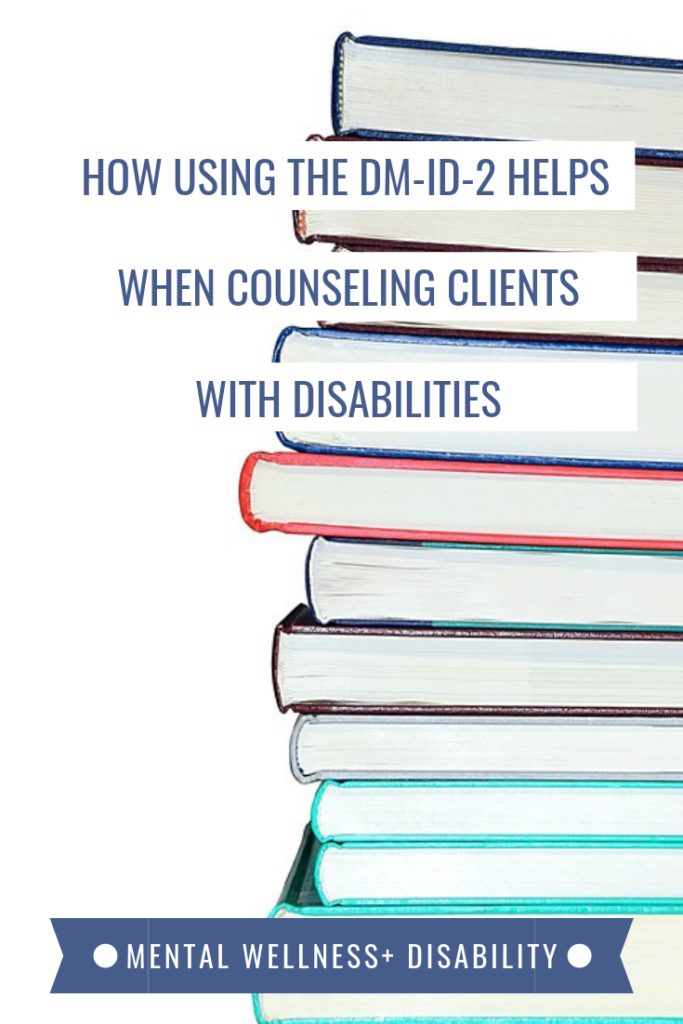I sometimes hear from therapists looking for tips on counseling people with intellectual and developmental disabilities. I almost always encourage them to pick up a copy of the DM-ID. This book will help ensure that diagnose and treat their client accurately based on the client’s developmental needs.
But very few therapists have ever heard of this diagnostic resource.

Of course, all therapists are familiar with the Diagnostic and Statistical Manual. The American Psychological Association publishes this book, and is in its fifth revision. Clinicians commonly refer to it as DSM-V. This is the standard classification guide to mental disorders used by mental health professionals in the U.S.
What many clinicians don’t realize is that the APA also works in collaboration with the National Association for the Dually Diagnosed (NADD) Jointly, these groups publish the Diagnostic Manual-Intellectual Disability (DM-ID-2). This book is a companion and adaptation to the DSM-V. Its focus is specifically on diagnosing mental illness in people with intellectual disabilities.
An aside for those who aren’t familiar with the NADD. The NADD promotes mental wellness for people with intellectual disabilities. Since 1983, they have supported this mission through research and professional education and certification. I recommend their continuing education offerings to therapists who want to provide counseling to people with disabilities.
How the DM-ID-2 is like the DSM-V
Overall, the format of both manuals is quite similar.
Chapters of disorders. The DM-ID-2 covers the same diagnostic categories of mental health disorders outlined by the DSM-V (for instance Depressive Disorders or Personality Disorders).
Expert-consensus model of content development. Experts collaborated to write the chapters in both manuals (the expert consensus model). In the case of the DM-ID-2, groups of 3-8 experts in each area of diagnostic criteria collaborated to develop the content of that chapter.
How the DM-ID-2 differs from the DSM-V
Where the differences between the manuals is evident is when the symptoms for various disorders are compared. There are several ways that diagnostic criteria differ in the DM-ID-2.
Addition of symptom equivalents. In some cases, DM-ID-2 authors include observable behaviors as diagnostic criteria. These behaviors are included when they are the equivalent of self-report criteria in DSM-V. For example, irritability is a behavioral indicator of Depression in people with intellectual disorders.
Omission of symptoms. There are sometimes symptoms that do not exist or that clinicians cannot identify in persons with I/DD. These are removed from DM-ID-2 as possible diagnostic criteria.
Change in symptom count. The DSM-V will specify that a certain number of a group of symptoms must be present over a specified time for a diagnosis to be given. For example, to diagnose a Major Depressive Disorder (MDD) using the DSM-V, 5 of 9 symptoms must be present to warrant diagnosis. However, when using the DM-ID-2, only 4 symptoms of MDD must be present to justify a diagnosis.
Change in symptom frequency. In some instances how often a symptom is observed or experienced has been changed from the DSM-V criteria.
Modification of age requirement. To diagnose Antisocial Personality Disorder in the DSM-V, symptoms of the disorder must have been present prior to age 18. For this and a handful of other disorders, the age cutoff is extended to account for the delayed development of people with I/DD. In the case of Antisocial Personality Disorder, for instance, the age cutoff is 21 years.
Value-Added Chapters
Clinicians wanting to work with people with disabilities will appreciate the value-added chapters in the manual.
One of these chapters covers assessment practices. The chapter outlines how to do a comprehensive biopsychosocial evaluation of a person with developmental and intellectual disabilities.
The other chapter gives an overview of the behavioral phenotypes of certain disorders of behavior and development, including how acquired mental health disorders may manifest (the fancy term for this is a disorder’s pathoplastic effect). This chapter includes symptom profiles which can be very valuable to clinicians learning to work with people with developmental disorders.
Why it’s important that clinicians use the DM-ID-2 when counseling people with disabilities
Clinicians should diagnose and plan treatment for clients with disabilities using DM-ID-2. I’ve discussed many of these reasons at length in posts like this one about mistakes that counselors make in therapy with people with disabilities And this one about what makes it difficult to diagnose depression in people with Down syndrome. To summarize, the main reasons it’s key to use the right diagnostic manual with this population include:
Diagnostic overshadowing. It is always essential that health care professionals avoid Diagnostic Overshadowing. This is when a person allows one diagnosis to explain everything they are seeing the person do. They don’t notice if the evidence suggests something else may be going on. At best, the risk of diagnostic overshadowing is failing to consider the person holistically. This denies them the correct treatment and support. In more extreme cases, diagnostic overshadowing can lead to extreme pain or even death.
Different progressions of mental illness. Psychiatric disorders simply don’t look the same in people with certain disabilities. Of all the reasons listed here, this is the area where my field of counseling psychology has the most to learn. This is exciting to me as a clinician. I am hopeful that in a few short years we will understand much more, and be able to offer better care to patients with disabilities.
Difficulty with self-report. This is where I see many clinicians trip up when trying to work with clients with intellectual disabilities. In school and early practice, we learn that the true hallmark of many mental illnesses is whether they are distressing to the person. We know if symptoms are distressing because the person tells us. They say things like “I’m tired of being so sad, I just want to enjoy life again”. But what about when a person isn’t able to fully articulate their internal experience in a way that others can understand? Then it’s really challenging to know if their feelings upset them. The DM-ID-2 is a wonderful tool because it has been developed with this challenge in mind.
If you’re a clinician wanting to purchase the DM-ID-2, you can purchase it directly from the NADD here, or you can order from Amazon here.
If you have questions about the DM-ID-2 and its use, leave them in the comments and I’ll do my best to answer them.
Keep reading
Other posts you may be interested in
How to Know if Someone is a Real Friend. A Quiz for Teens and Adults with IDD.
In my counseling practice, I offer mental health counseling for teens and adults with IDD. Many of my clients who have Down syndrome, Cerebral palsy, and other disabilities have lots of meaningful friendships in their lives. But sometimes, they ask “how can I know if someone is a real friend?” Maybe you have a friend […]












